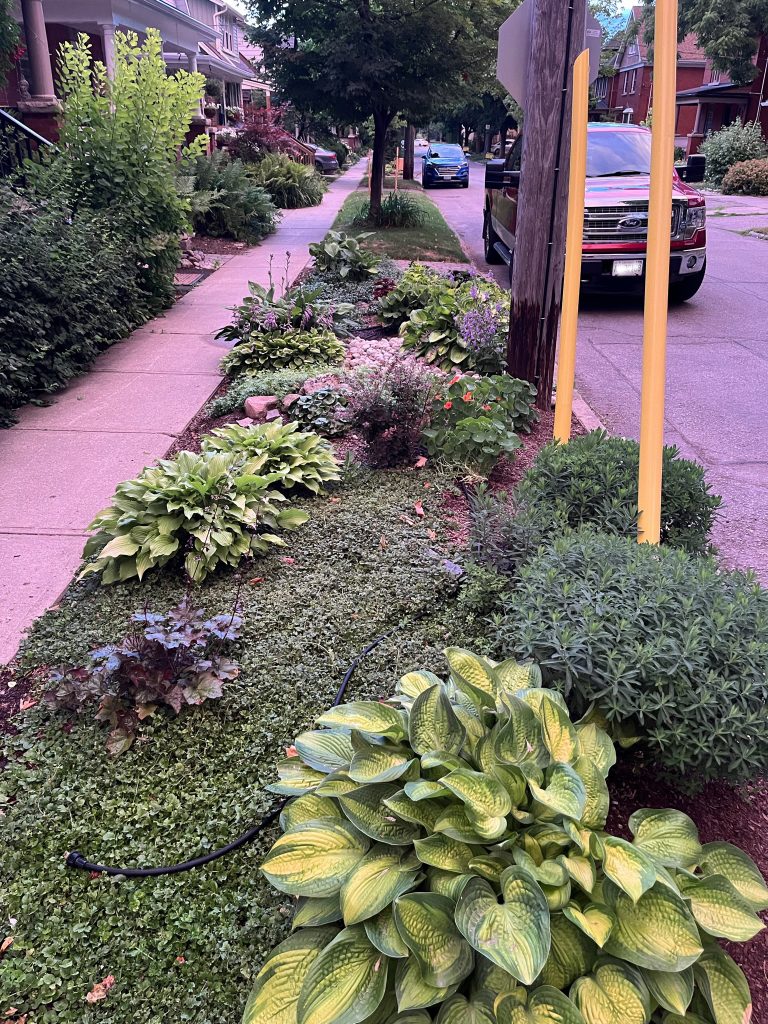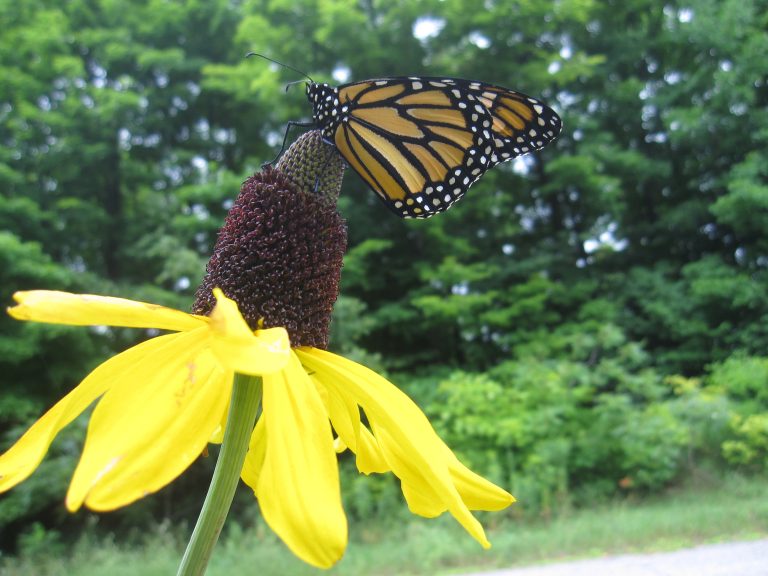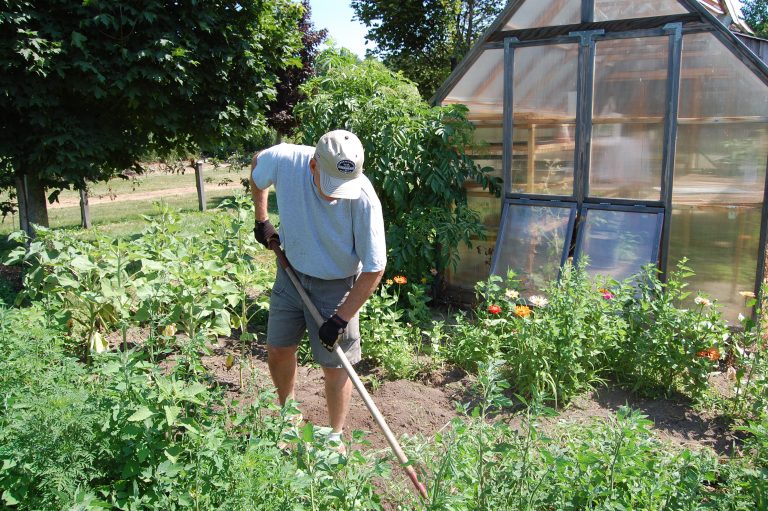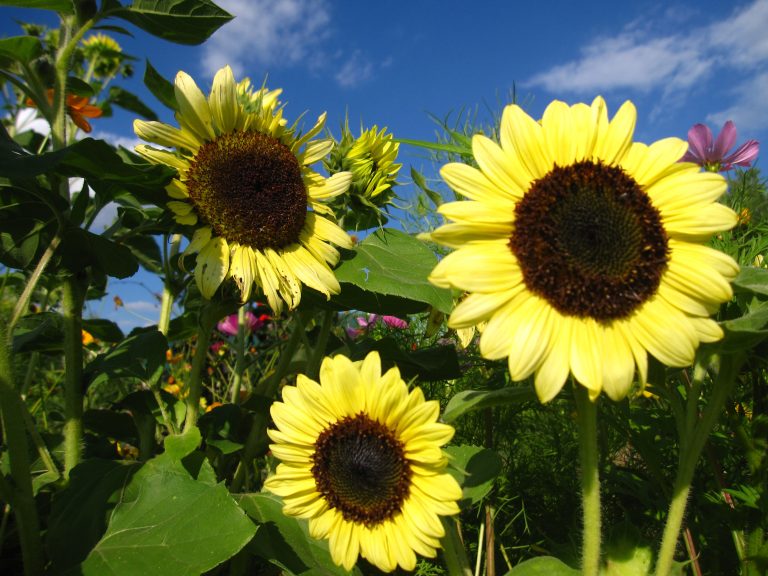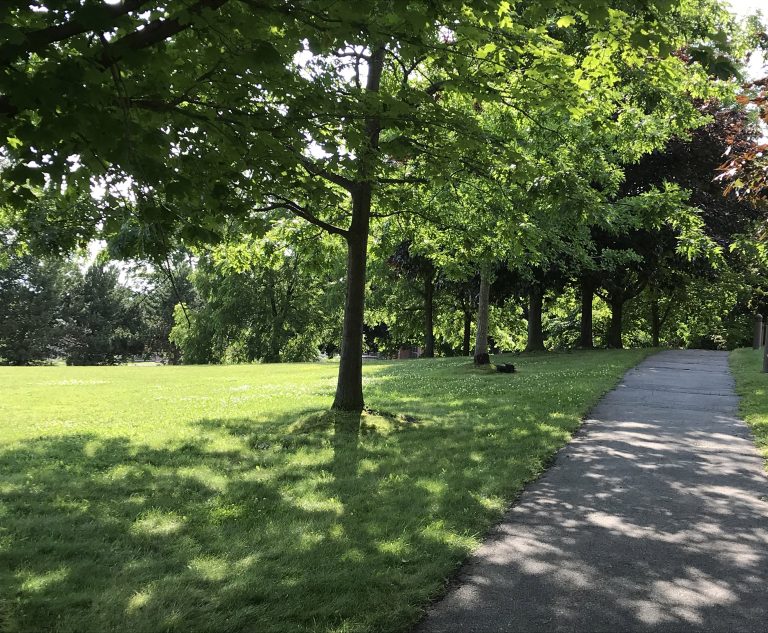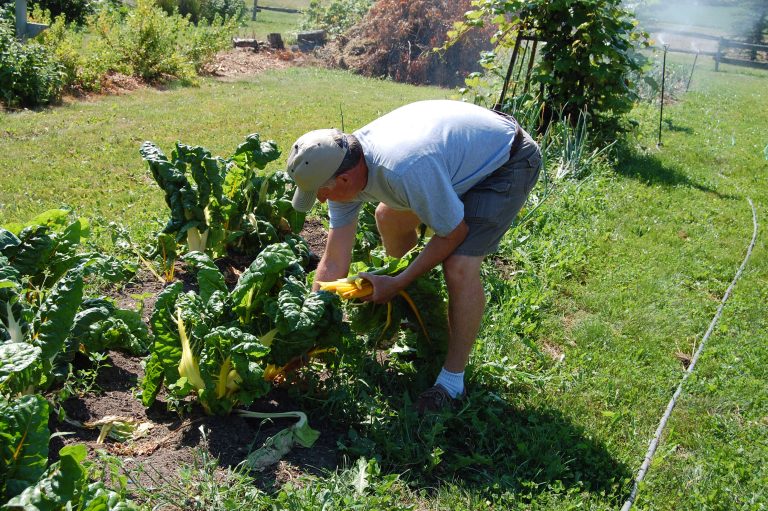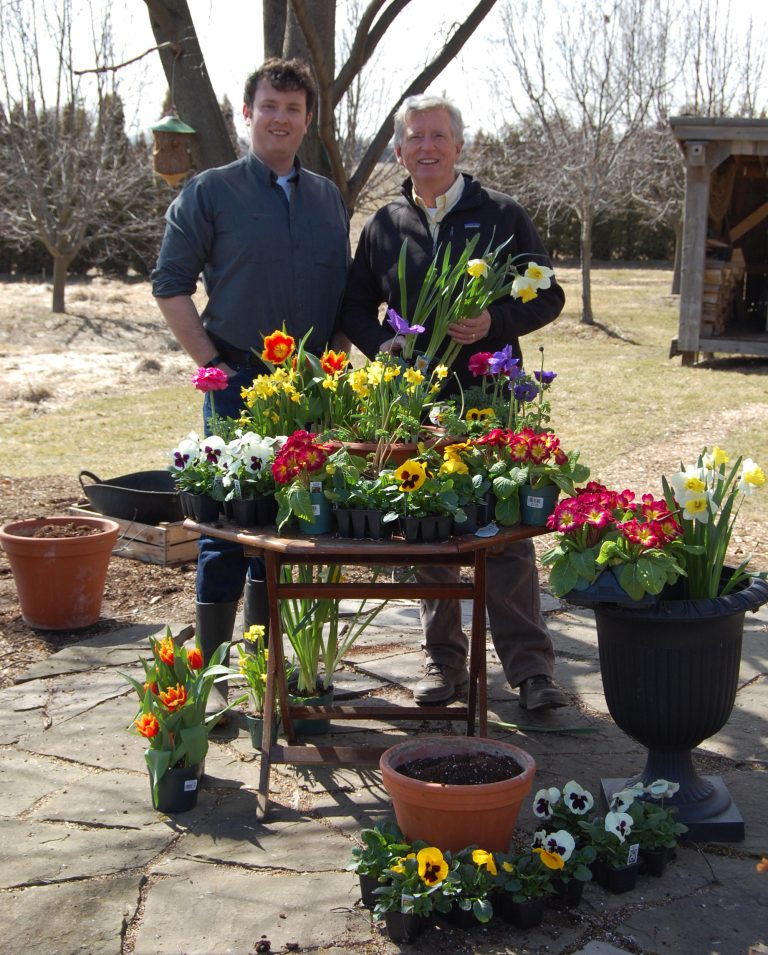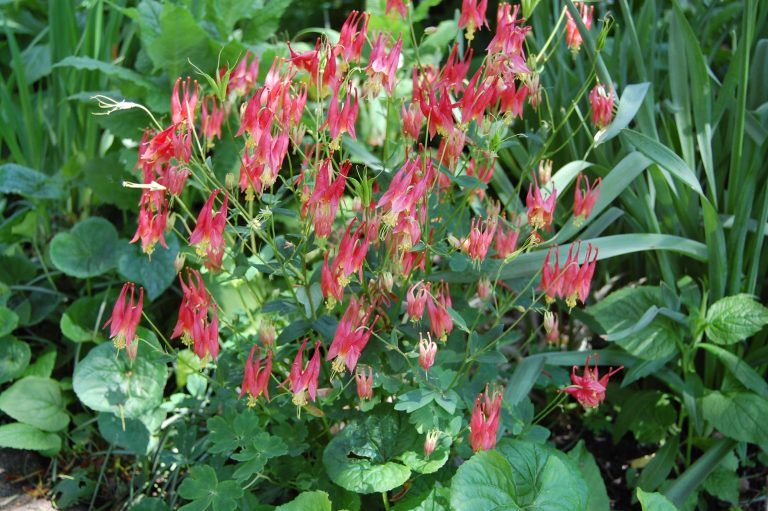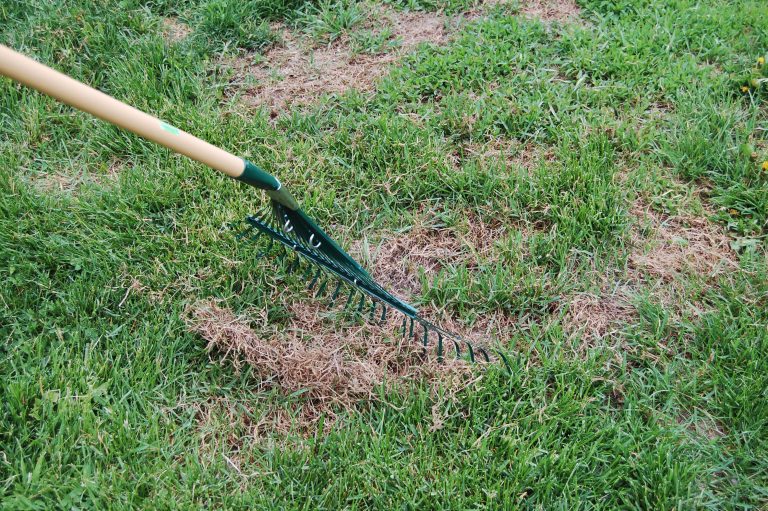Real estate is a necessary part of gardening, and we know how precious real estate is in this country. Especially in our cities.
It is a reasonable temptation to view city-owned boulevards as an opportunity to expand our garden vision – in some places, like Ben’s hometown of Guelph, it is even encouraged.
Within the city of Toronto, boulevard-gardeners’ experiences are mixed. Gardening on someone else’s property, even public property, means playing by their rules, and with the city, that can vary based on local by laws, public use or neighbour complaints.
Generally, gardening on city boulevards is tolerated, provided it is maintained and does not obstruct visibility of traffic. Should the City decide to clear the boulevard for any reason, you would not be entitled to consultation – the garden would have to go.
In gardening circles, this strip of land is often referred to as the “hell strip”, where dead grass or an unhealthy tree are often the dominate features. Cultivating a boulevard garden can provide food for humans or habitat for wildlife and it can improve the appearance of your neighbourhood. Another reason to beautify your boulevard is because you love gardening. Who cares if what we create is not made for eternity?
We recommend that you consider the following when planning a boulevard garden:
• Site prep. As ever, the first ingredient to garden success is site and soil preparation. An environmentally friendly method to convert grass to garden is by putting down a layer of uncoated cardboard, covered with at least four inches of bark mulch, and left for a year to allow the underlying grass to die and the cardboard to decompose. To speed things up, add a 5 or 6 cm layer of triple mix between the cardboard and the mulch which will provide a good “bed” for your new garden.
• Keep a low profile. While a complaining neighbour may get the attention of city officials, creating a safety hazard by obstructing the view of traffic is sure to bring your plan to a brisk conclusion. Consult with your neighbours in advance and look for groundcovers and plants that will not exceed 16 to 25 cm in height along any sightlines.
• Keep the soil low, too. Avoid the temptation to mound up your beds higher than the sidewalk like the plentiful gardens you might have in your yard. One of the benefits of a hell strip garden is storm water retention, so it’s important to keep the soil level at or below the sidewalk to allow water to flow into it. This may require you to remove existing soil to create an environment that encourages plant health. Be sure to “call before you dig” if this is the case.
• Plant selection matters. Ideally, a mix of very hardy perennials will provide a reliable repeat performance from year to year. Consider planting a scree garden in particularly arid and harsh environments. Scree gardening mimics the nutrient-poor environment of the high alps, where you would use rocks and gravel for mulch and drought tolerant perennial plants such as creeping thyme, sedum, supervivum, and dwarf conifers. Any opportunity to plant native perennials is also welcomed, as the goal is to add as much value to the ecosystem as possible.
• Food crops if you’re careful. The risk of growing food so close to traffic is that crops could potentially absorb road salt and heavy metals from car pollution and runoff. This is particularly true of leaf crops like kale where there will be a higher concentration of ground-source metals in the edible leaves. Best to avoid unless your street is particularly low traffic.
• A place to step. Lest your new garden be trampled by passengers getting into and out of street-parked cars, it’s a good idea to place flagstone or mulched paths throughout the garden as a place for considerate travellers to plant their feet without crushing your creation.
Green your community by reclaiming the “hell strip”. And remember that you are doing this to have fun.
Mark Cullen is an expert gardener, author, broadcaster, tree advocate and Member of the Order of Canada. His son Ben is a fourth-generation urban gardener and graduate of University of Guelph and Dalhousie University in Halifax. Follow them at markcullen.com, @markcullengardening, and on Facebook.
Planning a boulevard garden
Hummingbirds and Butterflies To Beat the Band
Why do we love gardening so much? Not just us, but Canadians in general. Perhaps it is the company we keep while in the garden that makes the idea so attractive.
Take butterflies and hummingbirds for instance. This time of year, they are everywhere: are they in your garden? Chances are they are in the neighbourhood. But they need an invite to be a part of your garden. They are welcome guests, as they are primary pollinators and one third of the food we eat is made possible by their work.
Here is a list of our seven favourite butterfly and hummingbird plants that can be planted now, many of them will bloom this season:
Butterfly weed (Asclepias tuberosa). Ignore the “weed” part of the common name of this plant. Butterfly weed is a desirable addition to any sunny garden. Broad, fragrant blooms in late summer attract butterflies in a big way. Most cultivars mature to about 80 cm tall and equally wide, though some are smaller.
Milkweed (Asclepias). Another weed, that is not, though it once was. The definition of a weed that we like is, “A plant whose virtues that have not yet been discovered”. Milkweed is a native pollinating plant that not only attracts the Monarch butterfly, but it is the only source of sustenance for their larvae (caterpillars). The world needs more monarch butterflies. Sow milkweed from seed most any time, in an open, sunny position. Grows to 120 cm and produces a fragrant, umbel of flowers this time of year.
Yarrow (Achillea millefolium). The perfect flowering perennial tolerates long periods of drought, is self propagating, flowers for weeks at a time mid to late summer, produces bright, primary-coloured blooms, cuts nicely for use indoors and attracts butterflies. What is not to like? Grows to about 40 cm. Insists on bright sunshine.
Sedum. The ever-popular sedum spectabile is indestructible, grows in a wide variety of soil types, flowers from late summer through fall, sometimes for up to 10 weeks and butterflies love it. Grows to 30 cm. Sun. Other, lower growing varieties are great for bordering a sunny garden or planting on a rooftop. Sun.
Trumpet Vine (Campsis radicans). A hummingbird magnet. Large orange, trumpet shaped flowers featured on a twining vine that does not stop. We recommend heavy annual pruning to keep it under control. Most brightly coloured, trumpet shaped flowers attract hummingbirds, with their long bill and a tongue that moves almost as fast as their wings, any plant with trumpet shaped flowers that are nectar rich will attract them. We recommend old fashioned nicotine, lupines, and foxglove.
Cardinal Flower. Perennial Salvia. All salvia is nectar rich and generally they fall into the “hot colours” category, which is good. Perennial salvia is amazing at attracting hummingbirds. Cardinal flower blooms for several weeks late in summer too. 60 cm. Sun.
Shasta Daisies (Leucanthemum × superbum), Rudbeckia (Rudbeckia fulgida), and Coneflower (Echinacea). We classify these flowering perennials together on purpose as each of them features a flat landing surface, perfect for butterfly landing and each produce lots of pollen or nectar or both. For a succession of bloom from one end of the season to the other we recommend:
Shasta Daisies for late spring, early summer, flowering up to 4 weeks.
Coneflower for early to mid summer, flowering up to 6 weeks.
Rudbeckia for late summer, early fall, flowering up to 10 weeks.
Plant all 3 of these species and you will enjoy a nonstop show. And your butterflies will too!
Note that the mature flowers of Coneflower and Rudbeckia produce seed heads that attract singing finches by the dozen. A sound you will learn to associate with autumn as your finch population grows.
Mark Cullen is an expert gardener, author, broadcaster, tree advocate and Member of the Order of Canada. His son Ben is a fourth-generation urban gardener and graduate of University of Guelph and Dalhousie University in Halifax. Follow them at markcullen.com, @markcullengardening, and on Facebook.
Checking the Right Boxes
The long weekend of our national holiday, July first, has a habit of creeping up on us gardeners. No sooner do we get our gardens planted and we sit for a moment to enjoy the view when the heat of summer comes down upon us and we have a new list of things to do.
This is our lament and our joy: any time in the garden is a good time to find worthwhile things to do.
Here is our timely list of suggested things to do in your garden.
Water. Your newly planted garden demands water in the heat of July to a much greater degree than it does come August because it is developing new, young roots. As plant roots grow deeper, the need for water lessens. Allow the surface of the soil to become dry between water applications. Established plants, that have been in the ground for more than a year seldom need watering. We do not recommend watering the lawn at all through summer, let it go dormant when drought occurs and be sure to set the inground watering system to manual, using it only as needed.
Water features. Now is a great time to add a water feature to your garden. You can create an elaborate water pond, stream or fountain and treat the construction as a fun summer “vacation” project or just fill a large watertight container with a water lily and other water plants, maybe a goldfish or two to keep mosquitoes at bay. Be sure to add oxygenating plants like duck weed or water hyacinth to keep the water clear.
Deadhead. This is simple and can generally be performed with a drink of choice in one hand. Pinch out the finished flowers of annual plants that go to seed. Finished geranium, petunia, marigold, and zinnia flowers demand this attention now. When you pinch out the finished flower you are rewarded with more fresh flowers. Also remove spent blossoms from peonies, lilacs, and roses to encourage more flowers later. It is a profitable arrangement for the attentive gardener.
Prune. When you look at the plants in your garden today you will no doubt notice how they have grown over the spring months. This is the perfect time of year to tackle pruning jobs. Here is our summary of what/why:
Flowering Shrubs. Prune after blooming. Spring blooming shrubs like lilac and spirea are best pruned now. Cut new growth back to bring it under control, after all you must live with your plants and not allow them to take over the property. If the shrub is thick and mature, reach into the interior of the plant and remove up to one third of the growth into the wood with a pair of sharp hand pruners. This will encourage growth new growth on the old parts of the plant. Prune late flowering shrubs after they bloom.
Shade trees. Maples, birch, and other hardwood trees are best pruned right now, while they are in full leave. Pruning while dormant can cause excessive bleeding of sap which can cause problems down the road. Prune to thin a tree and/or to give it a desirable shape. A sharp pruning saw is in order.
Evergreens. Evergreen trees lend themselves to early summer pruning, again, focusing on the shape that you desire. This time of year, you can bring an unwieldy looking spruce or pine and the like under control. Cedar hedging, boxwood, and junipers are best pruned now as they will fill in nicely over the summer, reducing the “just barbered” look that all of us have the day of a haircut.
In the upcoming months permanent “woody” plants produce a less aggressive flush of growth that will give them a lovely, fresh, finished look.
Think of your garden activity this time of year as an investment of your time that will pay dividends later in the season: more flowers, fruit, and healthier plants.
Cut and come again
As we pass the longest day of the year, June 21, the plants in your garden are responding to all that sunshine by growing to beat the band. The flowers too.
We encourage you to get out and enjoy the show as it is changing every day, though subtly. Your daily garden tour or condo balcony review reveals untold secrets including new flowers that seemingly appear over night.
Which reminds us that one of the best ways to enjoy the flowers in your garden is to cut them and bring them indoors, where you live. Having some “cutting flowers” indoors is a great treat for everyone who ventures indoors and is greeted by their colour and fragrance.
This is a perfect time of year to plant many flowering plants or sow seeds that will produce an abundance of long stem, often fragrant flowers for use all season long. Here is our list of the top 10:
Calendula. Pot Marigold. An old fashioned annual that your grandmother would have planted in a row in her vegetable garden. Sow from seed now in a sunny position and in 6 to 8 weeks you will have brilliant, orange, or yellow flowers suitable for cutting. Cut the stem deeply at first to encourage more flowers. 20 to 30 cm tall.
Cosmos. Also sown directly in the soil, Cosmos, which means “beautiful flower” in Greek, kosmos, matures to about a meter and a half high and produces an abundance of bright, hot coloured flowers in 8 weeks from seeding. Cut as often as you please as they are prolific. Pollinating insects love cosmos. Needs lots of sun.
Sunflowers. Start sunflowers by seed out of doors in the sunniest spot in your garden. They germinate in a week this time of year and grow like stink. Blooms occur in late summer or early fall and attract honeybees and native bees while in flower and songbirds, as they go to seed. Cut some of the long stem flowers before then to enjoy indoors.
Rudbeckia. Plant out now for perennial colour in August and September. Hardy perennial that clumps over time and produces more flowers each year. The award winning Goldstrum rudbeckia will bloom for up to 10 weeks, providing lots of opportunity to cut the flowers and enjoy. 120 cm high, sun.
Shasta daisy. Very popular as a reliable garden perennial and cut flower. So easy to grow there is a saying about “pushing up daisies” that suggests that when we die and are buried, they grow naturally on the plot. Hmmm. We will enjoy ours in the garden for now, thank you very much. About a meter high, sun. Look for award winning Becky.
Scabiosa. Do not let the name fool you, this is a handsome perennial with blue or purple pompom flowers born on long 20 or 30 cm stems. We love it. Sun to part shade.
Zinnias. An annual flower that produces all summer through early fall. For the best cutting flowers choose the tall growing “cactus” flowering varieties. Sun, meter high or more.
Bee Balm. Monarda. Easy to grow perennial featuring red or magenta flowers that attract bees and other pollinating insects. Adds a light, sweet scent to a bouquet. A meter high, clumps that get bigger each year in the garden. Sun.
Nigella. Love-in-a-Mist or Devil-in-the-Bush (who comes up with this stuff?). Looks great in the flower garden, best grown from seed directly sown in the garden or container. Adds a blowsy effect. 50 cm, sun.
Yarrow. A winter hardy perennial that will produce for many years. Flat faced flowers in bright primary colours including red, yellow, and orange. Thrives in a dry location. Sun, 40 to 60 cm.
A tour around your favourite garden retailer this time of year, and one last browse through the seed racks, can produce some surprising results for your cutting garden.
Mark Cullen is an expert gardener, author, broadcaster, tree advocate and Member of the Order of Canada. His son Ben is a fourth-generation urban gardener and graduate of University of Guelph and Dalhousie University in Halifax. Follow them at markcullen.com, @markcullengardening, and on Facebook.
Nurture Your Tree Investment
If you own real estate, chances are you have a tree or two growing on it. Trees are like oxygen: it is easy to take them for granted until we need them, or they disappear.
Your investment in mature trees cannot be measured in dollars as the time that it takes to grow one is priceless.
Take care of the trees on your property now and enjoy their many benefits for years to come. Here is our primer for tree care:
Water. A mature maple tree will transpire over 400 litres of water on a hot summer day, moisture is drawn from its roots. Generally, a tree does not need water from us after it has been established for four or five years. However, when the heat hits home, be prepared to provide a deep watering for any tree that may be at risk by leaving a trickle of water from the end of a garden hose for hours at a time, maybe a full day. This slow delivery of water will seep into the root zone where it is most needed. Small amounts of water applied frequently encourage shallow, drought prone roots, therefore watering your lawn does not count. You are better off not to bother.
Bugs. What is bugging your tree? Chances are not the bugs. We give bugs a bad rap. Trees and native bugs have worked out a symbiotic relationship whereby the tree needs the bugs as much as the bugs need the tree. An oak is the perfect example of a tree that attracts a host of bugs, over 400 species in fact. Bugs attract nesting insectivore birds, which nest in tree limbs. Bugs attract bats, also beneficial to the environment and marvelous mosquito controllers. When bugs are truly a nuisance is when invasive species take hold and do real damage to trees. Here are a few to look out for:
Gypsy moth. Native to Europe. The hairy caterpillar hatches in abundance midsummer and nibbles away tree leaves, sometimes denuding a tree of leaves entirely. Control them with a band of several layers of burlap tied around the tree trunk. Remove the caterpillars daily and drop into a bucket of soapy water overnight.
Emerald Ash Borer. Native to Asia. About 10 years ago the EMB moved through Toronto and devastated eight percent of our tree canopy, every ash tree in its way. Replant using a tree species that is not ash, or Fraxinus.
Japanese Beetles. Another pest that denudes trees of leaves early in summer. The only answers are food and sex pheromone traps. Hang them out as soon as you see an infestation. Empty them often.
We remind you that a naturally occurring bug is part of nature’s web and best ignored until some predator eats it.
We live in a world that is made up of nature’s web. Your garden is an important part of that web.
Environmental damage. A dead limb here, fallen branch in a windstorm there. Obtain the use of tree loppers or a long-poled tree saw. The saw is different from a wood working saw as it cuts on both the fore and back stroke and is designed for optimum use on green wood.
If in doubt, call an arborist. There are lots of “tree butchers” out there who are happy to take a chainsaw to your tree for a fee, whereas an ISA certified arborist has gone to school for years to learn their trade. Arborists are doctors of trees, committed to the health, safety, and long life of trees. Look for certification when shopping for tree advice and be prepared to pay a few hundred dollars for a consultation.
If you have a tree that is close to the street, chances are it belongs to the city. If you have concerns about its health, call the city and alert them to your concern.
As we approach the hot, sunny days of summer it is important that we don’t take the many benefits provided by a healthy tree canopy for granted.
Mark Cullen is an expert gardener, author, broadcaster, tree advocate and Member of the Order of Canada. His son Ben is a fourth-generation urban gardener and graduate of University of Guelph and Dalhousie University in Halifax. Follow them at markcullen.com, @markcullengardening, and on Facebook.
Top 8 Food Gardening Tips
The growing season has finally arrived and now you just wait for the everything to ripen, right? Wrong.
The road to a successful harvest is bumpy. But we can help smooth it out for you and enhance your chances of a bumper crop. Here are our top eight food gardening tips as we welcome June:
Stake. Double your tomato crop by getting the plants off the ground, where the fruit is susceptible to rot and ground dwelling insects. Get the air to circulate freely through the plant, the sun to ripen the fruit evenly and make better use of your vertical space.
Weed. Weeds need weeding out because they rob the soil of nutrients and the space around your desirable plants of, well, space. They are fierce competitors. This is the ideal time of year to cut them down with a sharp hoe or pull them root and all. No competition = better quality food plants and crops.
Water. Apply water infrequently. Standing at the end of a hose and soaking your vegetable plants might be good therapy for you but it is bad for plants. Best to water deeply but not too often. Push your finger into the soil up to the second knuckle. If the soil feels damp or cool, wait to apply water until it is dry. Then water thoroughly.
Mulch. Minimize the time it takes to raise quality vegetables, fruit, and herbs in your garden with mulch. We use a 4 to 5 cm layer of finely ground up cedar bark mulch around most of our garden plants. This insulates the soil from the drying effects of the sun, you water less often. And it reduces weeding by up to 90%. What are you going to do with all that extra time on your hands?
Compost. Add a layer of composted manure or finished compost from your composter around the root zone of all food plants, about three to four centimetres thick. A row of beans, beets, Swiss Chard, you name it, all benefit from the natural nutrients found in compost. A plant feeds itself by converting the energy of the sun and absorbing nutrients from the soil. Feed the soil and the plant will take care of the rest. Do this and there is no need for chemical fertilizers which, by the way, are going up drastically in price this year.
Bug the bugs. The Colorado potato beetles that plague your potatoes and the tomato horn worms that horn in on your tomato crop are not the boss. You are. Show them. Apply diatomaceous earth to the beetles (any beetles), it is harmless to humans and pets, and handpick the horn worms and drop them in a bucket of soapy water, ok, with a pair of gloves. Inspect your crop daily for pests. Once you find some, act. They quickly move this time of year, even the slugs. The ones on your couch, not so much.
Pick and enjoy. The leafy greens that are growing an inch a day will bolt to seed overnight if you are not paying attention. These are the longest days of the year, and the sun is at the highest angle in the sky, which means that every plant in your garden is growing faster now than ever. Most food growing in the garden is best picked before it finishes its natural job of going to seed. Rhubarb, lettuce, broccoli, cauliflower, and mesclun mix like to bolt right before your eyes.
Stop harvesting. Perennial food crops like asparagus, rhubarb and chives can be over-harvested. Be sure to leave some asparagus spears, rhubarb leaves (and stems) and chives to, well, chive on, because as they do, they build up energy in their root zone that will support the next healthy crop. Take no more than 60% of the crop and leave the rest.
You have waited all year for this very special time in the garden to arrive. Enjoy the growth, the freshness of summer and a healthy garden harvest.
Container questions answered
Everyone, it seems, is planting in containers. Condo owners create colour and grow food on their balconies while “home” owners do the same on the patio, front porch, and virtually everywhere that a pot or window box fits the bill.
What pitfalls are to be avoided? How can you get the best performance from your container grown plants: the most colour, butterflies, or tomatoes?
These are some frequent questions, and here are our answers:Should I use last year’s soil? No. The nutrients in last year’s soil are used up, and the only thing that might be “living” in it are spores for various root-bound diseases which you do not want to carry over. Time to refresh and revitalize using a quality mix that is designed and blended for container use. Do not throw last year’s soil out, put it in a garden and if you don’t have one, give it to someone who does.
Clay or plastic pots? We prefer clay as it breathes, transpiring moisture through its porous surface in exchange for oxygen. All plants like this arrangement. But it does mean that you will water a little more frequently than you would with plastic.
How do I choose plants for my containers? Ask yourself, “what am I trying to achieve?” A potted wildlife garden containing bee balm, echinacea, and marigold will attract beneficial insect and butterflies. If you just want colour, look for plants that suit the sun and wind exposure of the container’s location. It sounds simple but it is surprising how often people get this wrong. If you are growing food, like a tomato plant, give it enough space and sunlight to perform. A tomato plant will need two bushels of soil to grow well, which is more than most people realize.
Is drainage important? Drainage is the #1 consideration when choosing a container. There should be a minimum 2 cm hole for every square foot of soil surface. For any plant to perform well, water must move through the soil and out the bottom freely. Where it goes is another problem: onto the balcony below or your new outdoor carpet? We hope not. Best to obtain a saucer to catch the extra water.
How do I know when to water my container plants? While there is a wide variety of demands for water, depending on the plant type and species, our general rule is to push your index finger into the soil up to your second knuckle. If it is cool and damp, hold off, if it is dry, time for a good drink. Best to water thoroughly, less often, than sprinkle water every day. Note that most herbs perform well when allowed to dry between watering, as drying down minimizes the odds of root rot or fungal-borne disease.
Do I need to fertilize my container grown plants? Most quality container soil mixes contain slow-release fertilizer or enough organic content in the form of compost that no fertilizer is generally necessary until roughly mid-season. As plants mature they consume those nutrients, and as their roots eventually fill the container there is a greater need to fertilize. We recommend either an organic based liquid plant food or an application of water soluble 20-20-20 every week to 10 days to “top up” nutrients for best performance.
What do I do with my container plants when I go on vacation? If the containers are not too heavy, move them into a shaded spot and water them thoroughly just before you leave on vacation. If they are too heavy to move, just water them well before you go. Of course, the best course of action is to have a plant-sitter keep an eye on them. Our experience is that most amateur plant sitters tend to over water, so leave specific instructions to minimize the risk of returning home to rotten plants.
Growing in containers provides a great opportunity to maximize food, flower and greenery around your place. Go for it!
Mark Cullen is an expert gardener, author, broadcaster, tree advocate and Member of the Order of Canada. His son Ben is a fourth-generation urban gardener and graduate of University of Guelph and Dalhousie University in Halifax. Follow them at markcullen.com, @markcullengardening, and on Facebook.
Gardens that pop
“Plugged-in colour”. It is an expression that Mark made up while shooting TV, a few years ago.
Everyone that loves to create a flower garden or plant up containers with colour is looking for colour that, well, pops!
Let us introduce you to our favourite flowering plants that are guaranteed to attract attention:
Annuals:
- Portulaca. Plant in full, blazing sun and enjoy the knock-dead primary colours of this low growing ground creeper or use in containers to hang over the edge. Brilliant red, orange, yellow and pure white. Portulaca’s near relative Ice Plant features flowers that open in the sunshine and close late in the day when the sun is going down. A sunworshipper if there ever was one. Tolerant of dry conditions.
- Gerbera. Pure advertising. It is like someone wired them underground, in the root zone, with high voltage for colour. A member of the dandelion family, this flowering annual also blooms when the sun is shining on it and closes when the sun goes in. It wilts when roots are not moist but rehydrates like a sailor. Brilliant red, yellow, and orange. Grows to 15 or 20 cm height.
- Calendula. Once known as pot marigold, this hardy annual flowering plant produces hordes of bright orange flowers that are suitable for cutting. While it is technically an annual, Mark sows his calendula directly in the ground this time of year as the plants are marginally frost hardy. Old fashioned, easy to grow from seed. Matures to about 30 cm high. Plant in full sun. Blooms are edible.
- Zinnias. Perfect for the frugal gardener, as zinnias grow best when sown directly in the soil from seed. Perfect also for the cut flower gardener, producing a riot of colourful blooms born on short stems, 20 cm high “pom poms”. Prefers full sun.
For year-after-year colour, try these perennials for eye popping colour:
a. Gaura. A long flowering perennial that will thrive in your Toronto/zone 6 garden for three or four years then disappear. We have no idea where they go, but gaura is not exactly a true perennial the way daylilies and peonies are. But they are worth having for their pure white or pink spike-like flowers. Line your walkway up to your front door with gaura and the next Amazon delivery person may just knock on your door and ask what they are. Butterfly attractant.
b. Geum. Not as popular as it deserves to be, geum is a short, 20 cm high accent plant that flowers from late spring to early summer. Tolerant of dry conditions, look for bright orange, pink or yellow flowering plants.
c. Cardinal Flower (lobelia) Bright red, blooms in late summer through fall and is worth the wait. Attracts butterflies, hummingbirds and people who love bright primary colour. Perfect for your “Year of the Garden”, as we are all encouraged to plant plenty of red flowers this year during The Year of the Garden in Canada (https://livethegardenlife.gardenscanada.ca/). All the better, a native plant in southeastern Canada.
d. Columbine. Origami mixed. An eye-popper if there ever was one. Not a reliable perennial, but columbine will regrow in your garden for at least a couple of years. Matures to 40 cm height. Mixed, attention-seeking colours.
e. Phlox. Creeping phlox blooms this time of year and is popular as a rock garden plant that creeps over rocks and attracts attention to itself. Pink, white and violet. Summer phlox grows to about 75 cm high and flowers early to late summer. This plant deserves a shout-out from us as it is always shouting in technicolour.
There are many other brightly coloured plants that lend themselves to the attention-seeking garden including marigolds, peonies, daylilies and scabiosa. Take your time looking over the selection of Wow flowering plants early this season at your favourite garden retailer.
Mark Cullen is an expert gardener, author, broadcaster, tree advocate and Member of the Order of Canada. His son Ben is a fourth-generation urban gardener and graduate of University of Guelph and Dalhousie University in Halifax. Follow them at markcullen.com, @markcullengardening, and on Facebook.
Lawns and Lawn Alternatives
We get a lot of questions about lawns. Lawns are, after all, a point of pride for many homeowners.
Lawns are also subject to scrutiny from environmentalists who point out that a lawn does not support much in the way of biodiversity, and they can be demanding of water, especially for people who insist on keeping their lawn lush and green in the heat of summer. Fair points.
We take the middle-ground on the subject. Certainly, there are higher uses for a property carpeted in lawn from end to end, but sod can also serve as a useful filler and few ground covers stand up better to high traffic areas. We would certainly not recommend paving as an alternative.
Here are recommendations for the best-looking lawn this spring plus some alternatives to a lawn:
Rake using a soft rake, get air flowing through grass blades, to minimize snow mould and powdery mildew while accelerating your green up. Do not work too hard at this, you are not dethatching your lawn.
Aerate high traffic areas which are compacted from extensive foot traffic. Make sure you pull cores out of the ground when aerating, rather than using the spike method which simply compacts the soil in the wrong direction.
Fertilize using a slow-release spring fertilizer blend. Look for a slow-release ingredient that feeds your lawn over many weeks.
Overseed using a 3 cm layer of lawn soil or triple mix and a high-quality grass seed mix. Thickening your lawn in the fall and spring is your best defense against weed pressure throughout the season.
If you’re among the growing number of people who are looking to replace their lawn, here are our favourite ideas:
Grow food in a raised bed constructed atop your previous lawn. Build an open-bottom raised bed in a sunny part of your yard with a 10-to-20-page layer of newspaper at the bottom to smother the grass. Then back-fill with at least 30 cm of the best quality soil you can afford with a generous quantity of compost mixed with about 30% sand and plant your veggie garden!
Establish a “living carpet” of low-growing perennials. This works best in areas of lower foot traffic and be sure to avoid invasive plants such as Periwinkle (Vinca minor), English Ivy (Hedera helix), and Goutweed (Aegopodium podagraria). Wild Strawberry (Fragaria virginiana) is a native that grows well amongst existing lawns, will tolerate light foot traffic and shade, produces flowers for pollinators in the spring and tiny, sweet strawberries later in the season. Blue Violet (Viola sororia) is a fast-growing groundcover that pairs well with Wild Strawberry and is a host plant to Fritillary butterflies. Pennsylvania Sedge (Carex pensylvanica) is another native which tolerates moderate foot traffic. Unlike typical turfgrasses, Pennsylvania Sedge is an important host plant for some butterfly species.
Go the Easy-Route, with an “Eco-Mix” from Ontario Seed Company (or the like). Consider the Flowering Ecological Seed Mixture (a blend of wildflowers and fescues), or the “Low Maintenance” mix. Start your seed as you would grass seed, overseeding a typical lawn but with a “wilder look”. While your neighbours might need some educating, the results require less water and fertilizer (if any) after it is established, while supporting an abundance of wildlife.
Go wild if you don’t need a place to run around or host picnics, look at your lawn area as a blank canvas for a whole new garden. Homegrown National Park is a movement started in the US by entomologist and author Douglas Tallamy to convert ½ of privately-owned lawns (20 million acres) to native plantings, creating much needed habitat for our biodiversity crisis. Learn more at https://homegrownnationalpark.org/
Six tools every gardener needs
Canadian philosopher Marshall McLuhan once said, “we shape our tools then our tools shape us”.
Gardeners understand this well and are known to form attachments to their favourite garden tools. Mark is leaving his favourite digging spade to someone special (can’t say who) in his will.
Having the right tools in the garden turns drudgery to joy and can improve us as gardeners.
With that in mind, here is our list of six essential garden tools:
Scoop, not a trowel. When you are down on your knees planting small perennials or vegetable transplants, you do not want to move soil by the thimble full. Rather, you want the option to move a volume of soil that makes it worth the effort. You need a scoop. Preferably a stainless steel (no rust, permanent edge) scoop that will stand up to moving volume, hitting the odd stone or layer of clay in the process. A scoop that will stand up to years of abuse. A good one is about $20 at most retailers.
Spade, not a shovel. There is nothing wrong with digging a hole with a shovel. We have shovels but we reach for a spade first, especially when it has been sharpened on a grinding wheel. A razor-sharp spade, which is a shovel with a flat mouth, is very handy for edging the lawn, picking up waste, digging and dividing perennials. It can move a greater volume of soil than a shovel, reducing the workload and helping you be more efficient with both your body movement and time.
Hand pruners, but good ones. Stems and small branches often need attention. The idea behind pruning is to control Mother nature to the extent that you and she can live together. We spend a lot of time clipping small branches. When we get the timing right, we maximize the flowering potential for many roses and flowering shrubs. A cheap pair of hand pruners will twist in your hand and not hold an edge while you work. A quality pair will cut through green wood like a hot knife through butter. And they will last a very long time. The best in the business is Swiss made Felco, which run about $70 or more and are worth every penny.
Leaf rake, a stiff one. You can buy a broad leaf rake for $8 to $30. The difference is the quality of the tines, which should flex and return to their original position while in use. This is called “memory” and you want to have good memories of using your leaf rake. Not only handy for raking fallen leaves come autumn but for garden clean up this time of year, excess grass clippings and even debris from the driveway. Noiseless compared to a leaf blower.
Hoe. Choose your weapon: a Dutch (push) or draw (pull) hoe. They all do the same job of cutting down weeds in their prime, while they are young. The hoe that works best for you is a personal matter. We like the traditional farmer’s draw hoe. When you bring a new one home be sure to sharpen it on a grinding wheel if you have one or use a good file.
Orchard “tripod” ladder. Whether taming a vine or pruning mature trees, gardening is an activity which sometimes requires us to go vertical. These instances can pose safety risks, and if you have ever felt a traditional A-frame ladder teeter on soft ground then you know what we mean. For these tasks, we find a three-legged orchard ladder is best. Orchard ladders have a wide flare at the bottom of the climbing side, with a flared single leg on the other side which provides far superior stability on soft ground. A good orchard ladder can be hard to come by, so we recommend contacting a nursery supply company or ordering at HYPERLINK “https://gardenerskit.com/” https://gardenerskit.com/.
In this season of change, make sure you have the right tools at hand.
Mark Cullen is an expert gardener, author, broadcaster, tree advocate and Member of the Order of Canada. His son Ben is a fourth-generation urban gardener and graduate of University of Guelph and Dalhousie University in Halifax. Follow them at markcullen.com, @markcullengardening, and on Facebook.

